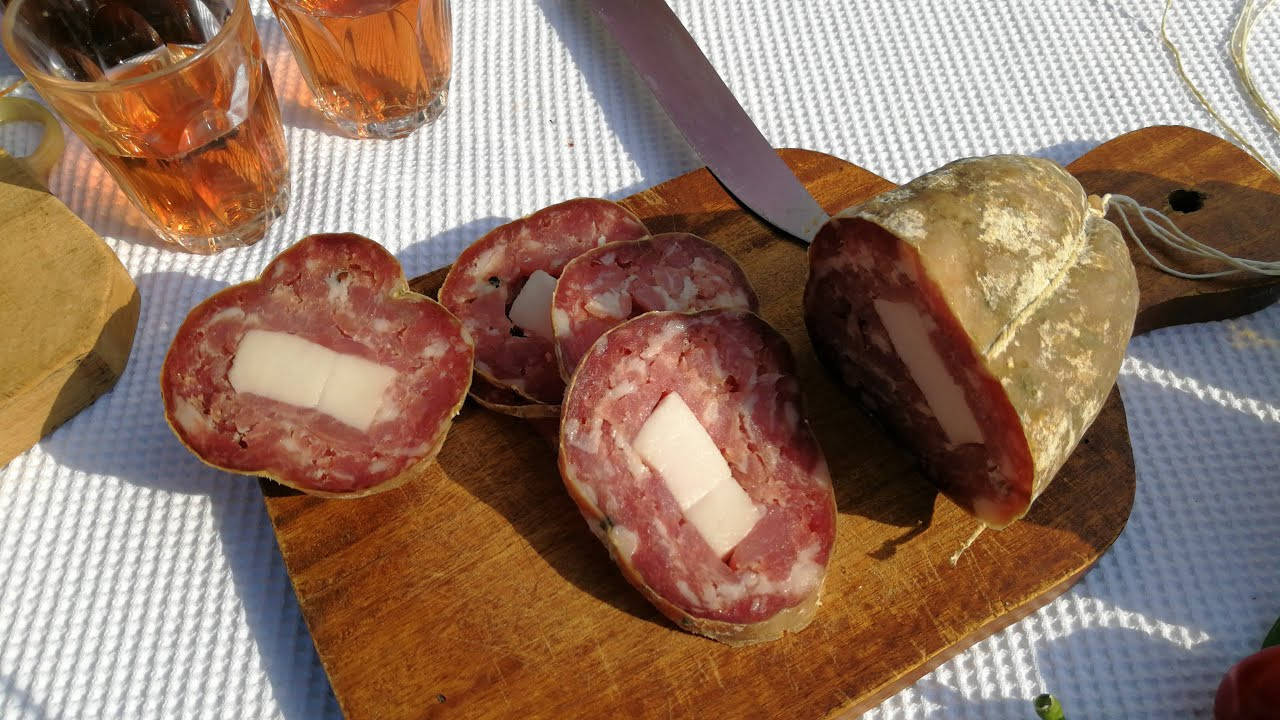Coglioni di Mulo - o Testículos de Mula - es un nombre algo colorido para un salami italiano hecho a partir de cerdo curado, caracterizado por un profundo sabor y aroma. Su nombre no es truco comercial alguno, pues su etimología se extiende desde muy atrás en el tiempo, tanto como su historia. Continúe leyendo para aprender más sobre este alimento, único en su género. ¡Le garantizamos que vale la pena!
OrígenesPara descubrir los orígenes del salami, necesitamos visitar los paisajes montañosos de la región italiana central de Abruzzo, la cual alberga a
Campotosto, un pequeño pueblo con una vista hacia un cautivador lago. Este es el ancestral lugar de nacimiento del Coglioni di Mulo, aunque su nombre es relativamente una invención reciente, tiene un poco menos de 100 años. Históricamente, a este salami se le conocía como
Mortadella di Compotosto.
Se solía producir en pequeñas cantidades, bien para uso familiar o para venderlo en los pueblos cercanos. Italia experimentó grandes cambios en el ámbito social que empezaron a principios del siglo XIX y se intensificaron tras la Segunda Guerra Mundial. Se construyeron carreteras y autopistas, y los coches y camiones sustituyeron a las mulas y los caballos. La gente viajaba más, y las mercancías también: los productos regionales se empezaron a vender en más sitios y llegaron a las ciudades principales. El embutido del que estamos hablando se empezó a vender al otro lado de los montes Abruzos, y llegó hasta Roma. De hecho, es ahí donde se bautizó esta especialidad con el nombre actual,
Coglioni di Mulo (testículos de mulo). Su peculiar forma es lo que inspiró a los romanos. Al parecer, los habitantes de la Ciudad Eterna veían este salami ovalado típico de Abruzos colgado por pares en los mercados locales y empezaron a llamarlo con el término en dialecto romano, cojoni de mulo, que enfatizaba el parecido del producto con ciertas partes del animal.
While it is of Abruzzan origin, a similar product exists in Norcia, near Perugia, in the central Italian region of Umbria. Recently, this item was given the same name. While it is also an excellent product, it cannot beat the original, whose authenticity is so niche that it cannot be mass-produced. Therefore beware, in case you’re in Assisi, Perugia, Orvieto or any other fantastic town of Umbria region, you will find “mule’s testicles” that taste differently than the one we’re writing about in this post.
 Preservation and PromotionThere are many regulations and initiatives in modern-day Italy
Preservation and PromotionThere are many regulations and initiatives in modern-day Italy that serve to protect biodiversity and promote local products, including authentic Mortadella di Campotosto. These take place both on the local level, thanks to the organization of regional producers, as well as on a national one, due to the efforts of the Ministry of Agriculture. In order to make genuine
Coglioni di Mulo, a producer must be verified and undergo strict controls, guaranteeing (s)he creates this item according to precise standards and rules pertaining solely to this product. This is what separates
authentic Coglioni di Mulo from the mass-produced variety that is sold in shops throughout central Italy. While quality, taste and aroma are of utmost importance, so are local sustainability, territory and producer. Genuine Mortadella di Campotosto is the result of artisanal production methods that have been preserved for over 500 years. There are very few who follow these techniques, often only at the family level. In fact, the number of
officially registered producers at the highest and most exclusive level, is only two!
How are they made Mortadella di Campotosto
Mortadella di Campotosto is a cured pork sausage. It is made in the winter using pork raised in Italy's Monti della Laga mountain range. Lean cuts from the shoulder and thighs are finely chopped together with pancetta – a type of Italian bacon made from pork belly.
Seasonings such as wine, salt, pepper and other spices are then added. This preparation is left to rest for at least 24 hours in a wooden bowl, so that the flavors blend together. After this, it is stuffed into a natural casing. One of its unique features is that the meat preparation surrounds a central
stick of lard, measuring approximately 10 cm / 4 inches, which runs the entire length of the salami. Only one of the salami's ends are tied, on the side where the lard was inserted. It is aged for 15 days in front of a fireplace, exposing it to fragrant oak and beech smoke. It is then left to mature naturally, in ideally humid, windy and cold conditions that can only be achieved in cellars filled with altitudinous mountain air. After three months, the product is ready, just in time for Easter!
La
Mortadela de Campotosto es conocida por su forma única: un par de dos salamis ovalados que se atan con una cuerda y se cuelgan de un palo. También es inusual cuando se corta en rodajas. La tripa tiene contornos irregulares, mientras que su carne, finamente picada, es de un agradable y uniforme tono rojo que rodea un característico y gran cuadrado blanco de manteca de cerdo.
Serving Suggestions
If you are lucky enough to get your hands on perfectly made authentic
Coglioni di Mulo while visiting Campotosto and its surrounding areas, you will not want to ruin the experience. The best way to eat this culinary delight is by cutting it into thick slices so that the lard melts in your mouth, blending with the lean meat, creating an amazing play on texture. You can also try this product with a piece of homemade bread. Finally, you will want to drink plenty of pure, clean spring water, which is found in abundance in the area, although the best accompaniment is an intense, full-bodied red wine, such as a Montepulciano d’Abruzzo.


